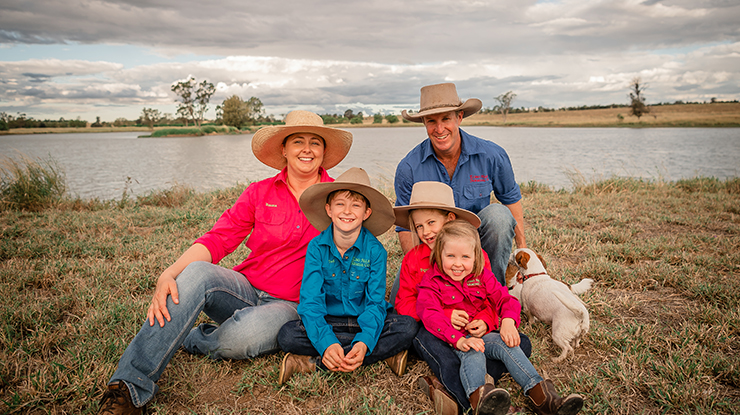Ag-tech delivers data nuggets
22 May 2024
 Queensland beef producers Emma and Angus King, with their children Ted, Pippa and Tilly
Queensland beef producers Emma and Angus King, with their children Ted, Pippa and Tilly
Key points:
- Don’t be afraid to trial new technologies, but be patient during the implementation phase.
- Know what you want from a product before you start researching. Make sure the technology you choose is aligned to your business goals.
- Build a good relationship with your vendors and ask for help when you need it. Implementing new technology requires a lot of input and communication.
Taking over the reins of a new property presents a steep learning curve about the land and environment – and this is where ag-tech can help.
When Emma King arrived at ‘Echo Hills’ in 2021, she relied on AgriWebb’s mapping tool to help navigate the property. Since then, she’s been an enthusiastic adopter of ag-tech in the south-east Queensland cattle enterprise she manages with her husband Angus.
The couple work with Peter and Nikki Thompson, who have owned Echo Hills for more than 50 years. The Thompsons purchased the neighbouring property, ‘Nugget Hills’, 13 years ago, bringing their holdings to around 8,000ha.
Diverse business
“We run about 300 Angus/Santa-cross breeders, as well as a small grassfed trading operation with 250 head,” Emma said.
“Our goal is to build a really sustainable, efficient breeding herd that’s providing grassfed beef to a local market.”
Last year, the business turned off rising two-year-old steers at 650kg (liveweight) off grass.
The business also incorporates agistment with capacity for 2,000–2,500 head, predominantly servicing local producers who can rapidly lift or drop their numbers in response to Echo Hills’ rotational grazing methods and seasonal changes.
Besides allowing flexibility in Echo Hills’ stock numbers, the agistment strategy also aligns to the Thompsons’ business, Soil2Soul, which is focused on promoting increased soil health and stability.
This means working with the land, not against it – a goal Emma said ag-tech can help facilitate.
“I think new technologies are enabling us to use traditional methods in a new way by providing better data and more accurate forecasts, with a centralised system which makes it easier to share information,” she said.
All data in one place
Echo Hills uses AgriWebb’s all-in-one livestock management system to centralise its data.
“It brings together all our farm data into one place, so I can see our grazing management, our breeding data, our Livestock Production Assurance (LPA) requirements, making our farm audits much simpler.”
She also appreciates how AgriWebb can link to the National Livestock Identification System (NLIS), which saves paperwork.
“It tracks cattle movements on the property and, when we truck them off, it links to my National Vendor Declaration (NVD) so I can see where they went and how much we made from them.”
The AgriWebb mobile app has a GPS locator which lets contract and seasonal workers find their way around the property without getting lost, making their jobs safer and more efficient.
Remote monitoring of water
Another vital ag-tech in operation at Echo Hills is Farmbot, which is used to record rainfall and remotely monitor tank and trough levels. They plan to also use it to operate and monitor pumps in the future.
“Across the two properties we might get a 20mm variation in rainfall between gauges, but Farmbot’s sensors have been really reliable, so we trust the data,” Emma said.
“We still check tank levels regularly, but we can remotely access Farmbot data online every day and enter it into AgriWebb.”
Improved forecasting
Echo Hills uses Cibo Labs’ satellite imagery of fractional ground cover to inform their grazing plans.
“It lets us see from our computer how much feed is left in a paddock. We can then calculate how many weeks’ feed we have left by looking at our rainfall, the predicted growth rate for the time of year, and the size of the mob in the paddock,” she said.
“Using this data and what we’re seeing on the ground, we can plan our cattle movements to avoid running out of feed or taking the feed too low.
“Another advantage is that it provides satellite imagery going back 30 years, so we can see the grazing history of the place and identify changes over time. That helps us ground-truth against the whole district and see if we are pushing things too hard in comparison, or whether we should be pushing a bit harder.”
Emma said the technology can sometimes struggle to distinguish colours, particularly where tree cover has distorted some feed estimates. Despite these teething problems, Emma is optimistic about ag-tech’s future potential.
“While the integration isn’t quite there yet, the fact our vendors are open to working with us to solve these problems is a real positive,” she said.
“The tech is only as good as what we put into it so the more ground-truthing producers provide, the better the algorithm will be and the more value we’ll get out of it.”
In-paddock weighing
Another useful innovation is an Optiweigh mobile unit (which won the 2021 MLA Producer Innovation Award), used to remotely track livestock performance.
“It’s so easy, you just put it in the paddock, set up a session, place the lick inside and the cattle come through. With our agistment herds, we could run 600 head in a mob and Optiweigh will identify the 120 that are ready to go,” Emma said. “It means we’re handling animals less which isn’t just more efficient, it’s also safer for us and less stressful for the animals.”


